Unicorn Sensory Rice
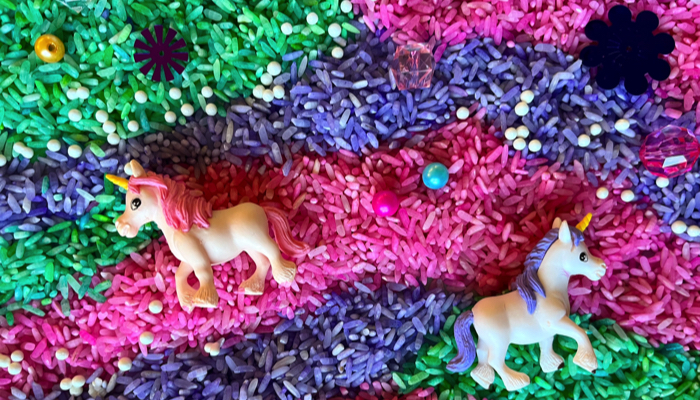
This post may contain affiliate links; please see our terms of use for details.
As a mom of five girls, it’s safe to say that unicorn activities are popular picks in our house. My girls love vibrant shades of pink, purple, and teal and anything that sparkles. When you combine these things, it’s sure to be a win.
Along with vibrant colors, my girls love interesting textures. Whether building sandcastles, making slime, or playing with water beads, they are all in. I love their curiosity about textures since sensory activities provide a variety of educational benefits.
One of our favorite sensory activities is creating sensory boxes. These boxes are full of different textures, colors, and even smells. When a child digs into a sensory bin it ignites their imagination while further developing cognitive and physical skills.
If you’ve never made DIY sensory materials, colored rice is the perfect way to start. Dying rice is simple and inexpensive. Making this one switch from white rice to colored rice will take sensory activities to a new level.
To make this unicorn sensory rice, you’ll only need a few supplies. From there, you can let your imagination soar and create endless activities.
Unicorn Sensory Rice: What You’ll Need
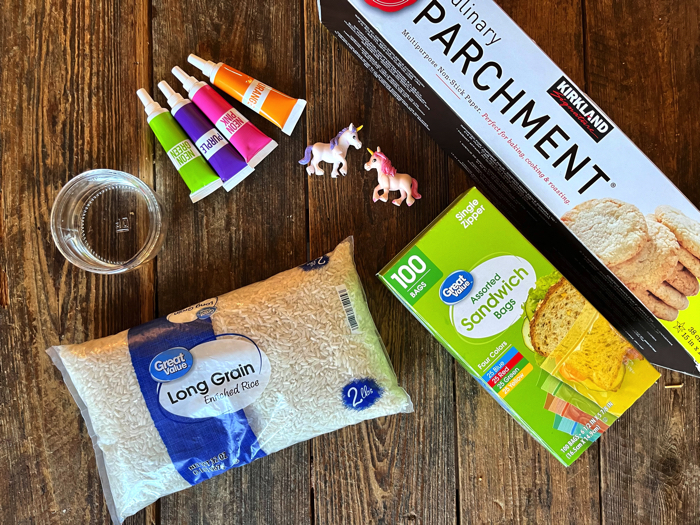
Let’s face it, as parents we have little extra time in our day. Though we’re often desperate for activities to keep our kids busy, we don’t have hours to spend creating them.
You’ll be pleased to know that dying rice is fast and mess-free. Follow along to create beautiful rice in no time at all.
Materials:
- White rice
- Food coloring
- Parchment paper
- Vinegar
- Ziploc Bag
How to Make Unicorn Sensory Rice
To dye the rice, follow these steps:
Step 1: Measure Out Rice
Measure out 1 cup of white rice and place it in a ziploc bag. Adjust the amount of rice depending on how much you need.
Feel free to substitute the white rice for what you have on hand. Just avoid darker varieties of rice, as the colors won’t turn out as vibrant.
Step 2: Add Color and Vinegar
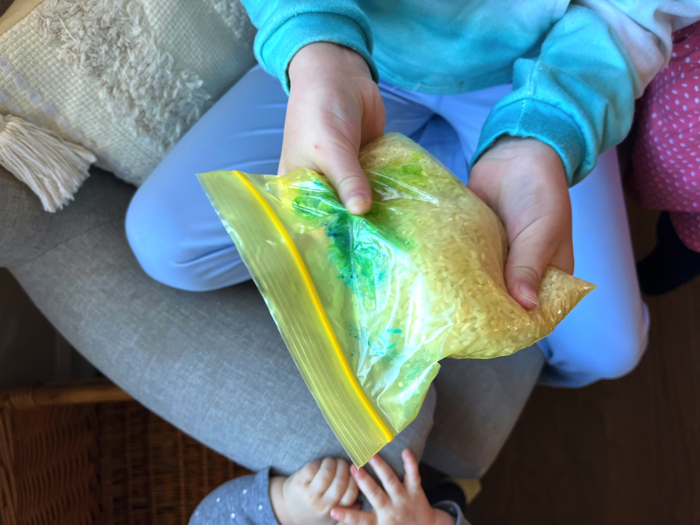
Add 4 to 6 drops of food coloring to the bag. Next, add 2 teaspoons of vinegar. Shake the bag until the color is evenly distributed.
Helpful hint: Depending on your food coloring type, you may need fewer or more drops. Some types are more concentrated than others. Keep adding color until you reach the desired result.
Step 3: Lay to Dry
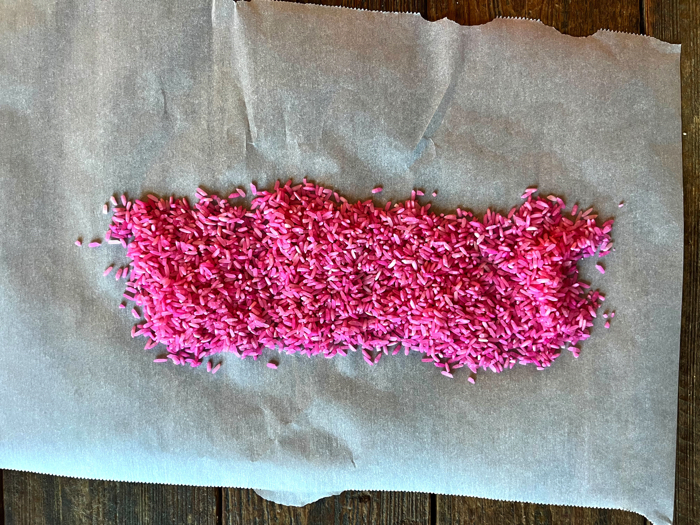
Place a piece of parchment paper on a baking sheet. (Wax paper would work as well.) Pour the colored rice over the parchment paper and allow it to dry.
Our rice dried within a couple of hours. You can also make the rice at night so it’ll be dry and ready for play the next morning.
Step 4: Store
Place the rice in an airtight container to store for playtime.
Time to Play
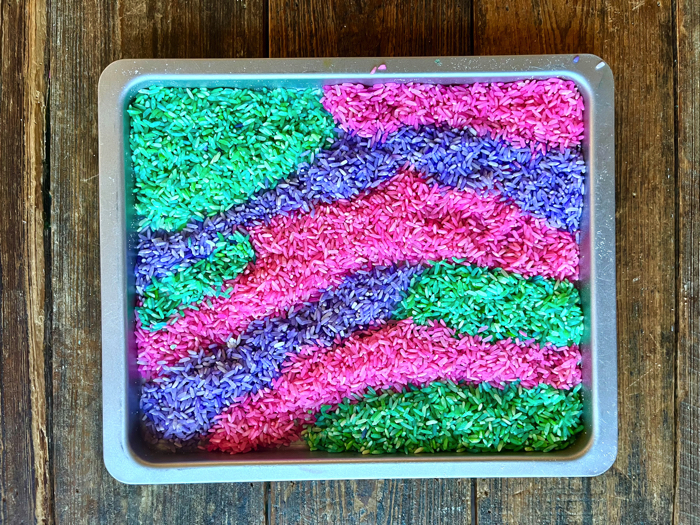
Once the rice is finished, you get to create a station for play that will spark creativity and stimulate your child’s senses. Here are some ideas on how to use this unicorn sensory rice:
Unicorn Pretend Play
Adding unicorn figurines to the rice creates a colorful field ready for unicorns to frolic in. My little one loved building the rice up into hills and letting the unicorn slide down them. She also buried them under the rice for a game of hide and seek.
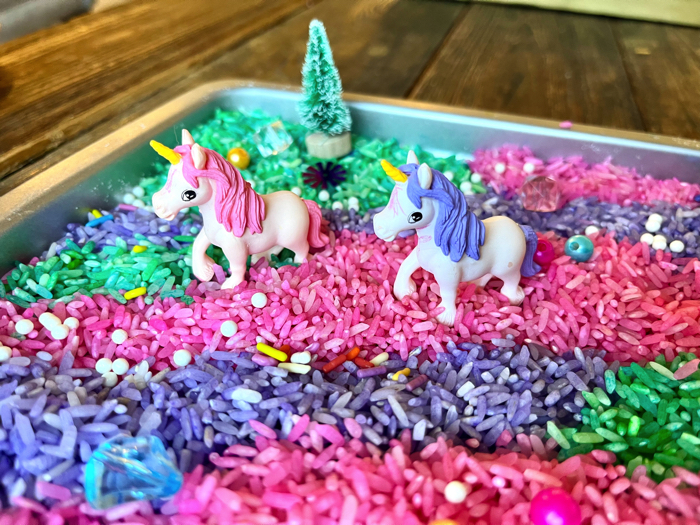
Pretend play may seem void of educational value, but it’s an important piece in a child’s development and crucial to the stages of play. Pretend play has the potential to build social-emotional skills, improve vocabulary, and more.
Scavenger Hunt
Using inspiration from our Winter-Themed I Spy Sensory Bottle, I hid objects in the rice for my kids to find. They had a list of random items to find and only a minute to do it. My older children also wanted to jump into the competition.
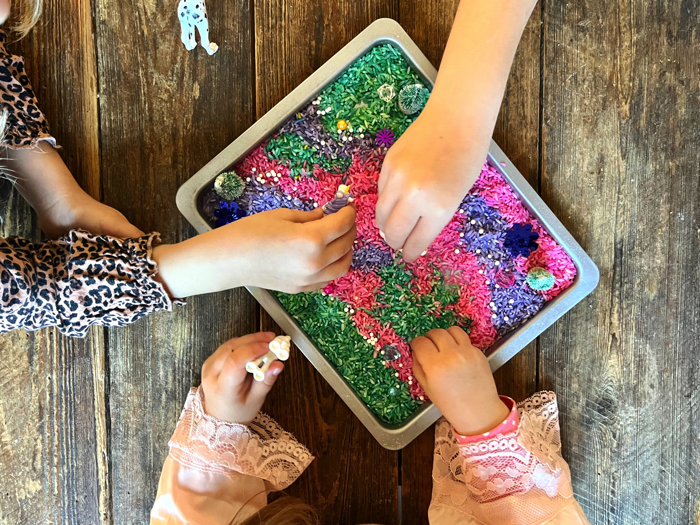
A few fun items to hide in the rice are marshmallows, beads, plastic rings, jewels, pom-poms, unicorn erasers, etc.
Unicorn Coffee Shop
If you give a preschooler a bin full of colorful rice, they’ll probably want a spoon and cup to go with it. Scooping and serving is one of kids’ favorite ways to play with rice. The stimulating sight and sound of rice pouring into a cup is too fun to pass on.
You can turn a simple bin of rice into a unicorn coffee shop by supplying a few coffee cups and spoons. Encourage your child to take orders for special unicorn drinks and fill the cups with the rice. To make the game even more fun, help your child create a unicorn menu for customers to order from.
Measurement Practice
If you think sensory rice is only for preschoolers, think again! Even my older children like the feel of rice pouring through their fingers or the sound of the rice hitting the bottom of a cup. I like to use play opportunities to sharpen their skills.
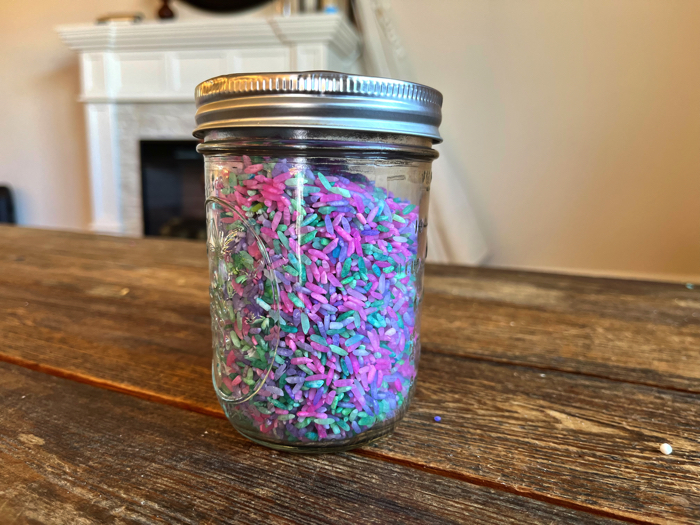
Rice is the perfect medium for practicing measurements. To do this, give your child an assortment of measuring spoons and cups. Call out measurements for them to scoop and have your child choose the correct cup or spoon.
This activity also allows you to talk about fractions and how to make a whole. Teach your child how many teaspoons make a tablespoon, how many ¼ cups make a whole cup, and so on.
Tactile Letter Formation
We love making sensory-rich letters like our tactile alphabet cookies or braille alphabet tubs. Using the unicorn sensory rice, you can create letters that are a feast for both the eyes and hands. All you need is paper, glue, and rice.
Start by drawing a letter on a sturdy piece of cardstock paper. Using a paintbrush, have your child cover the letter in glue. Finish the craft by letting your child sprinkle the rice over all the glue.
Rice Relay Race
If you want to get your child moving, host a backyard rice relay race. Give your child a tub full of unicorn rice and a plastic cup. On the other side of the yard, place an empty bowl.
Have your child race with cups of rice to the other side of the yard to fill the bowl. Time your child and challenge them to beat their previous time as they play.
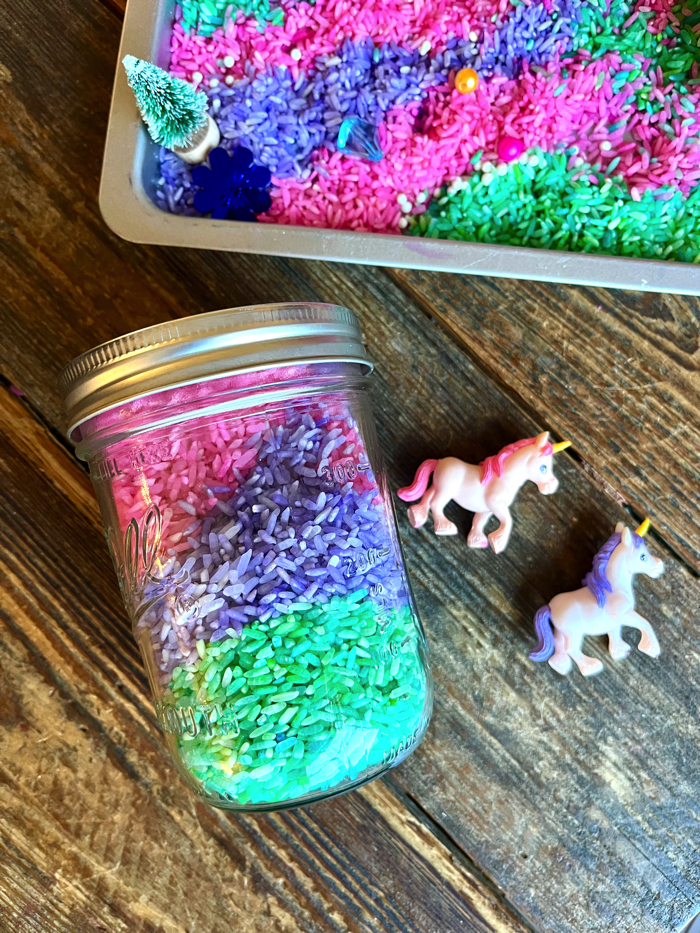
What Can I Use Instead of Rice?
Whether you’re making sensory tables, sensory bags, or sensory bins, there are several tactile fillers you can use. Instead of rice, try sand, salt, or pasta. To dye these items, follow the same steps used to dye the unicorn rice.
What Else Can I Add to the Unicorn Sensory Rice?
Unicorn sensory rice is both beautiful and fun. We found many items around the house that added more sparkle and sensory input to the bin. Here are a few ideas:
- Sprinkles
- Beads
- Glitter
- Miniature trees
- Unicorn figurines
What Are the Benefits of Playing With Sensory Rice?
Sensory rice doesn’t just keep your child entertained, it also helps develop their cognitive skills and motor development. Here are a few ways sensory rice can give your child an educational boost:
Builds Fine Motor Skills
Scooping, pouring, and grabbing all use small muscles in your child’s hands. For some children, these muscles take extra time and practice to strengthen and develop fully. Providing your child with fine motor activities for preschoolers is one of the best ways to workout these muscles.
As your child plays with the rice, you can challenge them by asking them to do more difficult tasks. For example, you might give your child an empty spice bottle and have them place one grain of rice at a time into the holes.
Provides Sensory Exploration
Sensory input is crucial for helping your child learn about their environment. Sensory bins made with rice offer tactile input which helps your child’s brain make new connections. Encourage your child to play with the rice in new ways and discuss the sights and sounds they encounter.
Calms Emotions
In our home, calming activities like reading a book, playing with sensory bottles, or exploring salt trays are popular choices for a child in the middle of a meltdown. If your child frequently experiences sensory meltdowns, having these activities on hand is helpful. Sometimes a distraction like molding playdough or scooping sand is all they need to reset.
What Other Ways Can I Enrich This Activity?
- Little Hippo Books (Author)
- English (Publication Language)
- 10 Pages – 08/29/2022 (Publication Date) – Little Hippo Books (Publisher)
To continue the fun, try one of these sensory activities:
- Read the book Chameleon’s Colors Children’s Touch and Feel Storybook by Little Hippo Books
- Try one of these sensory activities with water beads
- Go on a sensory nature scavenger hunt
- Create a necklace using dyed penne pasta and string
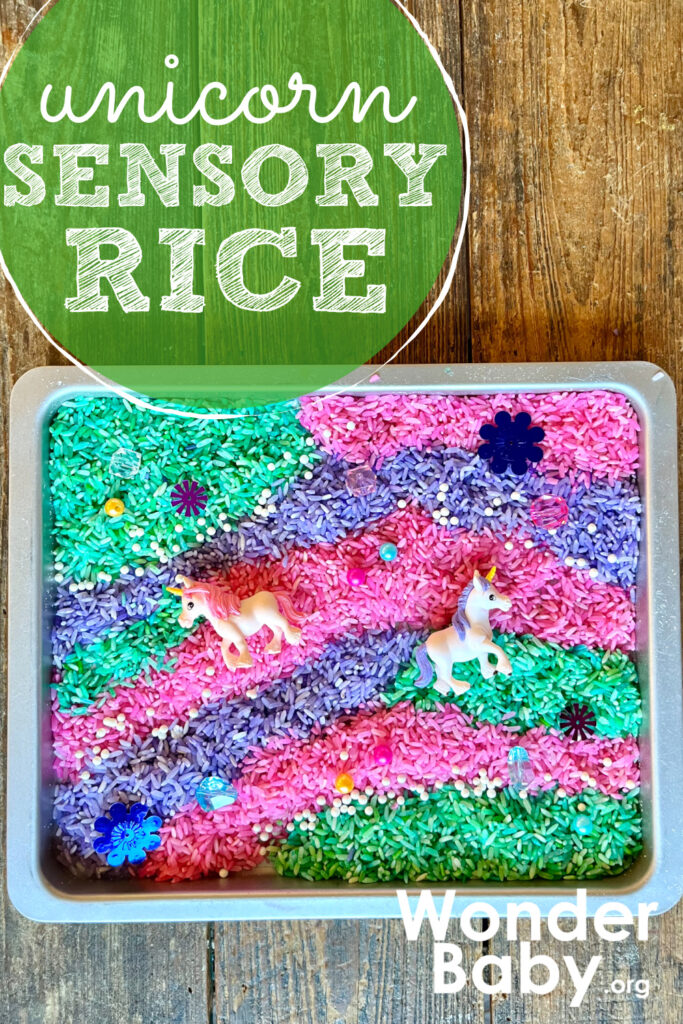
Related Posts
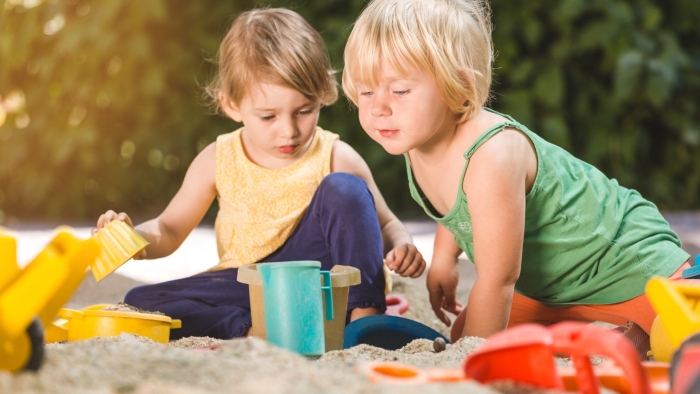
Sensory Activities
5 Sand Play Activities to Encourage Fine Motor Development
Sensory bin, at the beach, or in a sandpit? Try these sand play activities to help toddlers and preschoolers develop their fine motor skills.
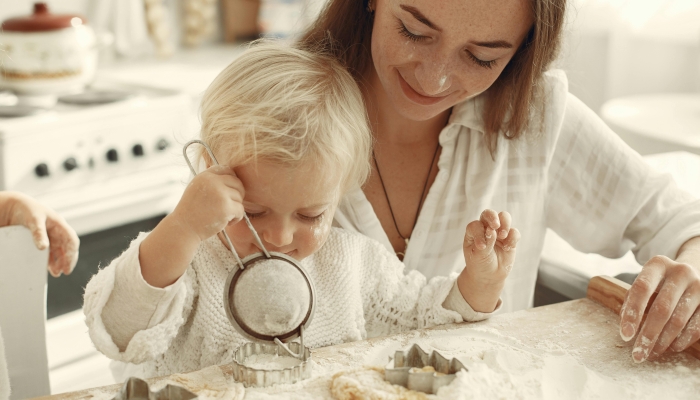
Sensory Activities
5 Edible Sensory Play Ideas
Check out our favorite edible sensory play activities to engage children's senses, boost their development, and provide hours of fun.
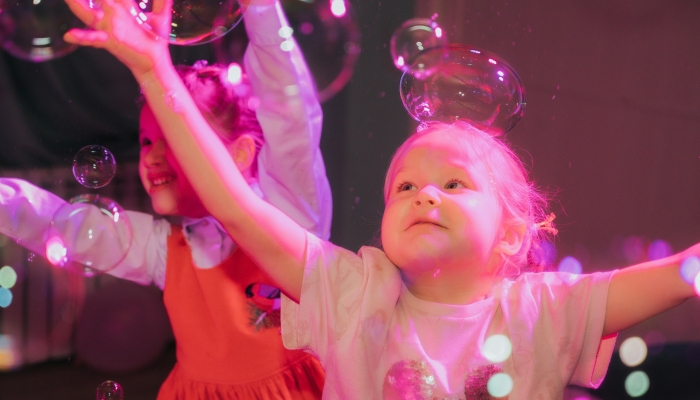
Sensory Activities
How to Make Unpoppable Bubbles
Discover the secret to making unpoppable bubbles with this easy guide. You only need three ingredients!
